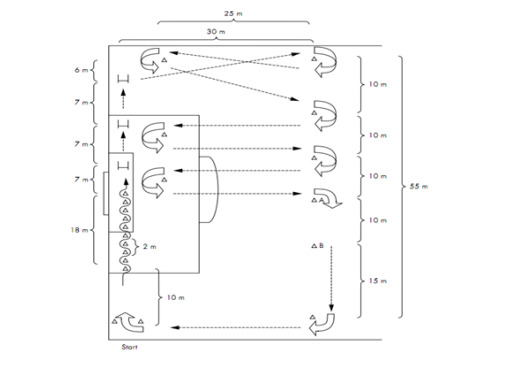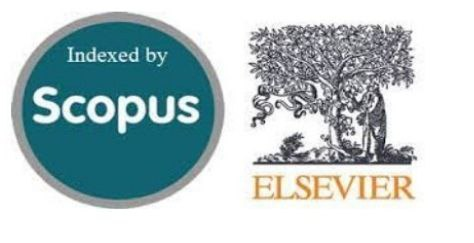A Comparative Study of Intense Continuous and Intermittent Aerobic Training on Physiological Factors in Football Players
Keywords:
Maximal Oxygen Consumption, VO2max, Heart Rate, Blood Pressure, Intense Continuous Aerobic Training, Intense Interval TrainingAbstract
Background: Identifying new training methods to enhance athletes' physical fitness and physiological factors has become a major focus for coaches and sports specialists. Aerobic training, especially high-intensity interval training (HIIT) and intense continuous training, are recognized for their effectiveness in improving health and performance metrics. This study compares these two training methods to assess their impact on specific physiological factors in young football players from Hamadan city.
Methode: This semi-experimental study involved 45 young football players who met specific inclusion criteria (e.g., non-smokers, no cardiovascular diseases, no recent structured exercise programs, etc.). The participants were randomly divided into three groups: an intense continuous aerobic exercise group, an intense intermittent program group, and a control group, each consisting of 15 players. The continuous aerobic group trained thrice weekly at 90-95% of their maximum heart rate, while the intermittent group performed 30 minutes of high-intensity training followed by 30 minutes of rest, also thrice weekly. Physiological factors, including maximal oxygen consumption (VO2max), heart rate, and blood pressure, were measured before and after six weeks of training.
Results: Both training methods significantly improved the physiological factors compared to the control group. However, intense continuous aerobic training showed more significant and substantial improvements. VO2max increased significantly in both experimental groups but more so in the continuous aerobic group. Similarly, both training methods resulted in significant reductions in resting heart rate and blood pressure, with more pronounced effects observed in the continuous aerobic group.
Conclusion: This study highlights the distinct impacts of intense continuous and intermittent aerobic training on physiological factors in football players. While both methods are beneficial, intense continuous aerobic training may provide more significant enhancements, making it a potentially more effective training strategy for improving the physical fitness and performance of football players. Further research could explore the long-term effects of these training methods and their impact on other performance metrics.
Downloads
References
1. Sanz-Matesanz M, Martínez-Aranda LM, Gea-García
GM. Effects of a Physical Training Program on Cognitive and
Physical Performance and Health-Related Variables in
Professional esports Players: A Pilot Study. Applied Sciences.
2024;14(7):2845. [DOI]
2. de Oliveira AF, Fidalgo ASF, Farinatti P, Monteiro W.
Effects of high-intensity interval and continuous moderate aerobic
training on fitness and health markers of older adults: systematic
review and meta-analysis. Archives of Gerontology and Geriatrics.
2024:105451. [PMID: 38718488] [DOI]
3. Buzdagli Y, Ozan M, Baygutalp N, Oget F, Karayigit R,
Yuce N, et al. The effect of high-intensity intermittent and
moderate-intensity continuous exercises on neurobiological
markers and cognitive performance. BMC Sports Science,
Medicine and Rehabilitation. 2024;16(1):39. [PMID: 38326816]
[PMCID: PMC10848527] [DOI]
4. Kayhan RF, Bayrakdaroğlu S, Ceylan Hİ, Eken Ö,
Bayrakdaroğlu Y, Badicu G, et al. Effects of different rest intervals
in high intensity interval training programs on VO2max, body
composition, and isokinetic strength and power. Journal of Men's
Health. 2024;20(5):1-11. [DOI]
5. Ruíz-Uribe M, Enríquez-Schmidt J, Monrroy-Uarac M,
Mautner-Molina C, Kalazich-Rosales M, Muñoz M, et al.
Moderate-Intensity Constant and High-Intensity Interval Training
Confer Differential Metabolic Benefits in Skeletal Muscle, White
Adipose Tissue, and Liver of Candidates to Undergo Bariatric
Surgery. Journal of Clinical Medicine. 2024;13(11):3273. [DOI]
6. Chalari E, Jones HS, Hadjicharalambous M, Fogarty
MC. The Impact of High-Intensity Interval Exercise Including
Acceleration/Deceleration Patterns on Redox Status of Healthy
Male Adults. Applied Sciences. 2024;14(6):2655. [DOI]
7. Peco J. THE COMMERCIAL ASPECT OF
FOOTBALL. ISSN 1512–875X (print) ISSN 2233–0852
(online).38.
8. Lee Y-S, Lee D, Ahn NY. SAQ training on sprint,
change-of-direction speed, and agility in U-20 female football
players. Plos one. 2024;19(3):e0299204. [PMID: 38478514]
[PMCID: PMC10936847] [DOI]
9. Yousefian F, Zafar A, Fransson D, Mohr M, Brito J,
Travassos B. Characterizing the most demanding passages of
kinematic and mechanical activity in elite football: a multifactorial
approach. Biology of Sport. 2024;41(4):41-50. [DOI]
10. Hemati Nafar M, Kordi MR, Chubineh S, Chubineh S.
The Effect of Six-weeks High Intensity Interval Training (HIIT) on
Fibrinolytic Factors (t-PA, PAI-1& t-PA/PAI-1) in Sedentary
Young men. Journal of Sport Biosciences. 2013;5(3):77-89. [DOI]
11. Somphong KR, Siswantoyo ES. The Effects of SpeedBased High-Intensity Interval Training on The Physical Fitness of
Elite Female Football Referees: A Pilot Study.
12. Poon ETC, Li HY, Gibala MJ, Wong SHS, Ho RST.
High‐intensity interval training and cardiorespiratory fitness in
adults: An umbrella review of systematic reviews and meta‐
analyses. Scandinavian Journal of Medicine & Science in Sports.
2024;34(5):e14652. [PMID: 38760916] [DOI]
13. Gaia JWP, Schuch FB, Ferreira RW, Souza EdL, Ferreira
VMS, Pires DA. Effects of high‐intensity interval training on
depressive and anxiety symptoms in healthy individuals: A
systematic review and meta‐analysis of randomized clinical trials.
Scandinavian Journal of Medicine & Science in Sports.
2024;34(4):e14618. [PMID: 38566446] [DOI]
14. Pourmand F, Ziaolhagh S, Molzemi S. Morphological
changes in lung tissue following the uptake of silver nanoparticles
produced by biosynthesis in trained male Wistar rats. Cell and
Tissue Journal. 2021;11(4):262-74. [DOI]
15. Fernández-Sánchez J, Trujillo-Colmena D, RodríguezCastaño A, Lavín-Pérez AM, Del Coso J, Casado A, et al. Effect of
Acute Caffeine Intake on Fat Oxidation Rate during Fed-State
Exercise: A Systematic Review and Meta-Analysis. Nutrients.
2024;16(2):207. [PMID: 38257100] [PMCID: PMC10819049]
[DOI]
16. Erb EK. The Effects Of High-Intensity Interval Training
At Normobaric Hypoxia On Measures Of Performance,
Hemodynamics, Autonomic Modulation, And Executive Function:
Kent State University; 2024.
17. Trapp EG, Chisholm DJ, Freund J, Boutcher SH. The
effects of high-intensity intermittent exercise training on fat loss
and fasting insulin levels of young women. International journal of
obesity (2005). 2008;32(4):684-91. [PMID: 18197184] [DOI]
18. Lin W, Su H, Lan X, Ni Q, Wang X, Cui K, et al. Effects
of high-intensity interval training (HIIT) and maximum fat
oxidation intensity training (MFOIT) on body composition,
inflammation in overweight and obese adults. Science & Sports.
2024. [PMID: 38786989] [PMCID: PMC11125445] [DOI]
19. Bennett GG, Wolin KY, Puleo EM, Mâsse LC, Atienza
AA. Awareness of national physical activity recommendations for
health promotion among US adults. Medicine and science in sports
and exercise. 2009;41(10):1849. [PMID: 19727030] [PMCID:
PMC4286240] [DOI]
20. Cadenas-Sanchez C, Fernandez-Rodriguez R, MartinezVizcaino V, de los Reyes Gonzalez N, Lavie CJ, Galan-Mercant A,
et al. A systematic review and cluster analysis approach of 103
studies of high-intensity interval training on cardiorespiratory
fitness. European Journal of Preventive Cardiology.
2024;31(4):400-11. [PMID: 37738464] [DOI]

Downloads
Additional Files
Published
Issue
Section
License
Copyright (c) 2024 Mohammad Ali Samavati Sharif, Massoud Ramezani, Hojjatollah Siavoshy (Author)

This work is licensed under a Creative Commons Attribution-NonCommercial 4.0 International License.







